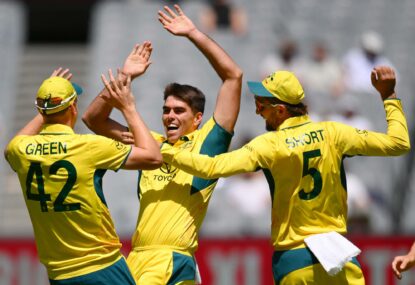Cathy Freeman’s gold medal, John Aloisi’s penalty and now Dave Warner’s switch-hit six. Sydney’s former Olympic stadium has a new image for posterity, especially among the schoolkids who represent cricket’s future.
Thousands of them saw it with their own eyes as they helped make history at Australia’s Twenty20 match against India, which drew a record Sydney cricket crowd of close to 60,000 at the city’s first cricket international played away from the SCG.
Many of them weren’t born when this stadium was built and this form of the game was invented.
Yet the match was very much about them, as cricket reinvents itself to appeal to younger audiences.
Their big drawcard Dave Warner scored just 25 runs but his audaciously improvised six will be long remembered.
Warner, T20 and ANZ Stadium symbolise the latest seismic influences on the once staid world of cricket, which learned from Kerry Packer 35 years ago that it is better to be the vanguard than the victim of change.
How deep and enduring this change might prove is a matter of conjecture, but for the time being it is causing a serious re-think among players, administrators, venues, sponsors, fans and TV networks.
The drastically abbreviated format of 20-overs cricket, introduced in 2003 to rejuvenate the moribund English county game, seems tailor-made for the attention span of modern tweens, teens and 20-somethings.
It’s not even one-day cricket, or half-day cricket; it’s three-hour cricket.
Almost everything that happens is accompanied by a burst of flame, the blare of rock music, booty-shaking dancers or a boisterous gee-up from the ground spruiker.
One or more of these embellishments occur not just after wickets, fours, sixes, 50s, 100s or between overs but after practically every ball.
Those who relish the chance to discuss the cricket, and life, will find themselves in alien territory.
Lovers of the exquisite, nuanced but prolonged banquet of Test cricket may be reluctant to get carried along with the “fast food” generation.
But 50-overs cricket was as shocking when it arrived.
And purists are facing informed challenge on one central contention – that slogging of the type required in the Big Bash and the lucre-laden Indian Premier League will ruin the technique of Test players.
It need do no such thing, say many top-liners, including former England captain Mike Atherton.
“Wristiness and elegance may give way to expressions of athleticism and pure power,” Atherton says, “but batting standards generally are on the rise.”
The poster boy for this argument is Warner, one of the first generation to emerge from the T20 era.
His 69-ball hundred in Perth against India, the fourth fastest in Test history, was hailed by Atherton as a “glorious exhibition of unrestrained but technically excellent hitting”.
Former Pakistan great Imran Khan, by contrast, attributes India’s sudden demise in two Test series slaughters to the rise of T20.
“If you put so much emphasis on Twenty20 you’ve got to pay,” Imran said.
But many believe T20 can co-exist with Tests in the same way that ODIs have, with some players appearing in all forms of the game and others specialising in one, or perhaps two.
Wednesday night’s Australia-India bash drew 59,659 spectators, beating Sydney’s previous record day of 58,446 for a Test at the SCG in 1928.
It was a ratings winner along the east coast for the Nine Network, which secured a peak audience of 1.89 million viewers, with an average of 1.46 million.
TV ratings for the revamped domestic Big Bash were so strong that the league is likely to go free-to-air when rights become available for the 2013 and 2014 seasons.
The Big Bash final between Sydney Sixers and Perth Scorchers at the WACA drew an average audience of 459,000 on Fox Sports, making it the seventh highest rating program in subscription TV history.
Weeks earlier at the MCG the Melbourne Stars and Sydney Thunder drew even more: 472,000, the fourth highest.
“We are very happy with the way it has gone. You couldn’t have asked for a better start,” said Cricket Australia marketing executive Mike McKenna.
The Nine Network, which has first and last refusal on free-to-air rights, is interested.
“Nine is the home of cricket and we like what we see in the Big Bash,” a spokesman said.
Bubbling along in the background is another major battle – stadium wars.
The big prize on the horizon is the 2015 ODI World Cup in Australia and New Zealand, which CA expects to play a major role in winning the next generation of fans.
The MCG is odds-on to host the final, but the SCG’s recently announced $186 million redevelopment will lift its capacity to near 50,000.
And now Sydney’s former Olympic venue is flexing its muscle as the brash new kid on the block.
ANZ Stadium is well placed to tap into the two million population of western Sydney, which is already a battleground for the country’s four football codes.
“We would love to be part of the one-day World Cup,” said ANZ Stadium chief executive Daryl Kerry, “and perhaps Australia will host a T20 World Cup in the not-too-distant future.”
“The MCG up to now has had pretty much carte blanche to get those big events because of capacity,” said Cricket NSW chief executive Dave Gilbert.
“This (Australia-India) match shows there is another player in the market.”
Gilbert believes ANZ Stadium could break the 80,000 barrier when Australia plays England in a T20 match there in two years.
Former Australian wicketkeeper Adam Gilchrist once pushed for T20 to be made an Olympic sport.
“It would be difficult to see a better, quicker or cheaper way of spreading the game throughout the world,” he said in the 2009 Cowdrey lecture at Lord’s.
If that happens, and Test matches retain supremacy in the game, maybe everyone will be happy.




































































































